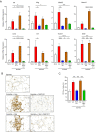Sotatercept analog suppresses inflammation to reverse experimental pulmonary arterial hypertension
- PMID: 35551212
- PMCID: PMC9098455
- DOI: 10.1038/s41598-022-11435-x
Sotatercept analog suppresses inflammation to reverse experimental pulmonary arterial hypertension
Abstract
Sotatercept is an activin receptor type IIA-Fc (ActRIIA-Fc) fusion protein that improves cardiopulmonary function in patients with pulmonary arterial hypertension (PAH) by selectively trapping activins and growth differentiation factors. However, the cellular and molecular mechanisms of ActRIIA-Fc action are incompletely understood. Here, we determined through genome-wide expression profiling that inflammatory and immune responses are prominently upregulated in the lungs of a Sugen-hypoxia rat model of severe angio-obliterative PAH, concordant with profiles observed in PAH patients. Therapeutic treatment with ActRIIA-Fc-but not with a vasodilator-strikingly reversed proinflammatory and proliferative gene expression profiles and normalized macrophage infiltration in diseased rodent lungs. Furthermore, ActRIIA-Fc normalized pulmonary macrophage infiltration and corrected cardiopulmonary structure and function in Bmpr2 haploinsufficient mice subjected to hypoxia, a model of heritable PAH. Three high-affinity ligands of ActRIIA-Fc each induced macrophage activation in vitro, and their combined immunoneutralization in PAH rats produced cardiopulmonary benefits comparable to those elicited by ActRIIA-Fc. Our results in complementary experimental and genetic models of PAH reveal therapeutic anti-inflammatory activities of ActRIIA-Fc that, together with its known anti-proliferative effects on vascular cell types, could underlie clinical activity of sotatercept as either monotherapy or add-on to current PAH therapies.
© 2022. The Author(s).
Conflict of interest statement
S.R.J., J.L., T.B., E.K.A., T.-H.K., M.L., E.B., M.S., R.G., M.C.M, J.L.F., K.W., S.D.B., M.J.A., B.R.H., R.C., R.S.P., P.A., R.K., and G.L. either are or were employees of Acceleron Pharma Inc., a subsidiary of Merck & Co., Inc., Kenilworth, NJ, USA, and may have owned stock in the company. P.B.Y has served as a consultant for Acceleron Pharma.
Figures






References
MeSH terms
Substances
Grants and funding
LinkOut - more resources
Full Text Sources
Other Literature Sources
Medical
Miscellaneous

